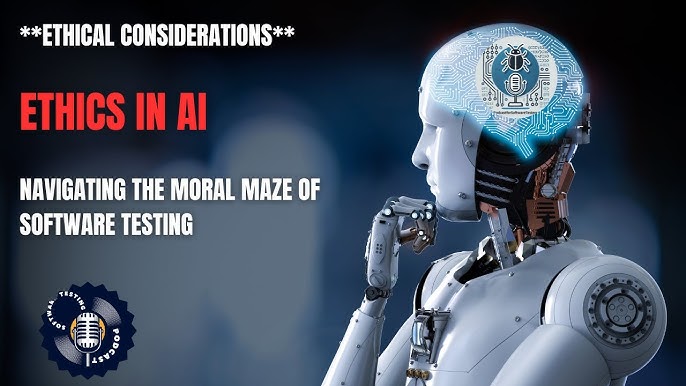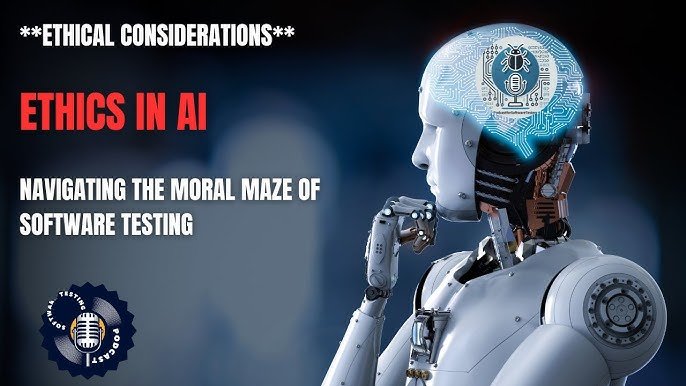
Understanding Ethics in Machine Learning Development
Overview of Machine Learning
As we dive into the realm of machine learning, it’s essential to grasp what this technology entails. At its core, machine learning involves training algorithms to recognize patterns by analyzing data. Imagine a personal assistant that learns your preferences—this is the magic of machine learning!
Machine learning forms the backbone of numerous applications today, including:
- Recommendation systems: Think Netflix and Spotify suggesting shows or songs you might enjoy based on your previous choices.
- Image recognition: Identifying faces in photos on social media platforms.
- Natural language processing: Enabling chatbots to understand and respond in a human-like manner.
The scope of machine learning is vast, and it’s constantly evolving. However, this brings us to a pressing question: as we harness its potential, are we also steering clear of pitfalls?
Importance of Ethics in Technology
Ethics in machine learning development is not just an afterthought—it’s a vital component that shapes the impact of technology on society. The decisions made during the development of machine learning systems can have profound consequences. For instance, if a facial recognition algorithm is trained on biased data, it could lead to unfair treatment of certain groups.
Why should we care about ethics in this context? Here are a few reasons:
- Trust: Building applications that respect privacy and human rights fosters trust among users.
- Accountability: Developers must be held responsible for their algorithms’ decisions.
- Social Responsibility: Ethical considerations promote a fairer and more just society.
In a world where technology is rapidly advancing, incorporating ethics into machine learning development is not just recommended—it’s imperative. As we continue with our exploration of its moral implications, let’s recognize the importance of maintaining that ethical compass.

The Moral Implications of AI
Bias and Discrimination in AI
As we venture deeper into the moral implications of artificial intelligence, one of the biggest challenges surfaces: bias and discrimination. Machine learning algorithms learn from existing data, and if that data is flawed, the consequences can be dire. For example, consider a hiring algorithm trained predominantly on successful past applicants. If this pool is biased toward a specific gender or ethnicity, the AI could perpetuate these biases, inadvertently disadvantaging qualified candidates from underrepresented groups.
Here are a few key points to consider:
- Data Quality: The old adage “garbage in, garbage out” rings true in AI. Poor-quality or biased data leads to skewed results.
- Impact on Society: Real-life examples, such as facial recognition technologies disproportionately misidentifying people of color, highlight the urgent need to address bias.
- Awareness and Training: Developers must be trained to recognize and mitigate bias, ensuring a more equitable technology landscape.
Privacy Concerns in Machine Learning
Moving on to another pressing issue, privacy is a fundamental concern in the realm of machine learning. With vast amounts of data being collected from users, how is that data being used, and who has access to it? Imagine a scenario: you trust an app to keep your health data private, only to find it shared with advertisers. This breach of trust can lead to significant privacy violations.
Privacy-related considerations include:
- Data Collection: Understanding what data is being collected and for what purpose is crucial.
- User Consent: Users should be informed and give explicit consent for their data to be used.
- Regulation and Compliance: Developers should adhere to regulations, such as GDPR, ensuring users’ rights are respected.
In our fast-paced digital landscape, addressing bias and privacy in AI is not just ethical; it’s essential for securing a just and respectful society. As we continue, let’s explore how ethical frameworks can help steer the development of machine learning technologies.
.jpg)
Ethics Frameworks in Machine Learning
Overview of Ethical Guidelines
As we continue our journey through the intricate world of machine learning, it’s essential to establish a robust framework to guide ethical decision-making. Ethical guidelines serve as a compass, helping developers navigate the complexities of deploying AI technology.
Generally, these guidelines emphasize fundamental principles such as:
- Fairness: Ensuring algorithms do not perpetuate bias or discrimination.
- Transparency: Being clear about how data is collected and how decisions are made.
- Accountability: Holding developers responsible for their AI systems’ actions and outcomes.
- User Privacy: Protecting individual data rights and maintaining confidentiality.
By adhering to these principles, organizations can foster an ethical culture that goes beyond mere compliance, enriching their projects and enhancing trust among users.
Implementing Ethical Practices in ML Development
Now that we have an understanding of the ethical guidelines, it’s crucial to translate these ideals into practical practices in machine learning development. Here are some steps organizations can take to implement ethical practices effectively:
- Diverse Data Creation: Actively seek out varied datasets that represent all population segments. This mitigates bias in algorithm training.
- Regular Audits: Conducting routine assessments of algorithms can help reveal irregularities or biases, allowing for necessary adjustments.
- Cross-Disciplinary Teams: Involve ethicists, social scientists, and diverse stakeholders in the development process to widen perspectives.
- User Engagement: Solicit feedback from users and affected communities to understand their perspective and experiences with AI systems.
By embedding these practices into the development lifecycle, organizations can not only meet ethical standards but also create technologies that genuinely reflect societal values. As we move forward, let’s consider the pivotal role of accountability and transparency in advancing ethical AI.
.jpg)
Accountability and Transparency
Explainable AI in Development
As we explore the significant domains of accountability and transparency in machine learning, one of the standout concepts is Explainable AI (XAI). This approach is pivotal for demystifying AI decision-making processes. Essentially, it’s about providing clarity on how models arrive at their conclusions, much like how a teacher explains solutions to a complex math problem.
Imagine you’re applying for a loan, and an AI determines your application is denied. Wouldn’t you want to know how that decision was made? XAI can help provide insights into essential factors influencing the outcome, such as credit history or income, offering a sense of fairness and understanding.
Key benefits of implementing Explainable AI include:
- Trust Building: When users can see and understand the reasoning behind decisions, trust in the system increases.
- Identifying Bias: One can more easily spot areas of bias or unfairness when evaluating how decisions are made.
- Compliance with Regulations: In many jurisdictions, providing explanations for automated decisions is becoming a legal requirement.
Ethical Decision-Making Processes
Transitioning into ethical decision-making processes, they are critical in ensuring accountability in AI systems. Establishing structured frameworks for making ethical choices aids developers and organizations in determining the best course of action when faced with dilemmas.
Key elements of effective ethical decision-making include:
- Stakeholder Engagement: Involving affected individuals, communities, and experts helps shape decisions that benefit broader groups.
- Scenario Planning: Anticipating potential consequences of AI deployment can guide more responsible choices.
- Documentation and Reflection: Keeping records of ethical considerations and decisions made allows for reflection and learning.
By prioritizing accountability and transparent practices, organizations can ensure their technologies not only innovate but do so in a way that is responsible and ethical. As we look to the future, let’s explore the regulatory challenges and compliance necessities surrounding ethical AI practices.

Regulatory Challenges and Compliance
Legal Frameworks in Technology
As we navigate the intricate landscape of technological innovation, it’s essential to address the regulatory challenges that accompany machine learning and AI. Legal frameworks are evolving to keep pace with these advancements, defining parameters for responsible practices in technology deployment.
For instance, the European Union’s General Data Protection Regulation (GDPR) has set a benchmark for data protection, impacting how organizations collect and use personal information. Here are some core components that highlight the regulatory landscape:
- Data Protection Rights: Users have the right to access, rectify, and erase their data, which necessitates transparency in data handling.
- Automated Decision-Making: GDPR mandates that individuals have the right to explanations when subjected to automated decisions, which directly ties into our earlier discussion about Explainable AI.
- Accountability and Fines: Non-compliance can lead to substantial fines, encouraging organizations to adhere strictly to regulations.
These frameworks are vital for accountable technology use, yet navigating them can be challenging.
Ensuring Ethical Compliance in ML Projects
Now, how can organizations ensure they remain compliant with these evolving legal frameworks while keeping ethics at the forefront? Here are some strategies to make ethical compliance a fundamental part of machine learning projects:
- Regular Training: Providing ongoing educational programs on ethics and legal regulations for all team members helps cultivate a culture of awareness.
- Auditing Processes: Conducting ethical audits can identify potential non-compliance issues before they escalate.
- Cross-Disciplinary Collaboration: Engaging legal, ethical, and technical experts in the development process can result in a well-rounded approach to compliance.
Ultimately, achieving ethical compliance in machine learning is not just about following regulations—it’s about fostering an environment of responsibility and trust. As we look ahead, it’s essential to consider the future trends in ethical AI to further our understanding of this dynamic landscape.

Future Trends in Ethical AI
Advancements in Responsible AI
As we step into the future of ethical AI, exciting advancements are emerging that aim to promote responsible practices across the board. One key trend is the growing emphasis on ethical AI frameworks, which help organizations set guidelines for AI development and deployment. This means that businesses are not merely focusing on innovation for its own sake, but are also integrating ethical considerations into their core strategies.
Some noteworthy advancements include:
- Automated Bias Detection Tools: Companies are now developing tools to automatically identify and mitigate bias in datasets, making it easier for developers to uphold fairness in their algorithms.
- User-Centric Design: There’s a heightened focus on designing AI systems that prioritize user preferences and promote transparency, ensuring that users have control over their data.
- Collaboration Between Stakeholders: Partnerships among academia, industry, and government are fostering a cooperative approach to tackle ethical challenges collectively, leading to a more balanced and responsible AI landscape.
Ethical Considerations in AI Research and Development
As these advancements flourish, ethical considerations in AI research and development remain paramount. Organizations are increasingly recognizing the need for robust research ethics that go beyond mere compliance. Here are a few critical ethical considerations for the future:
- Interdisciplinary Approaches: Involving ethicists, sociologists, and other experts in AI research can provide a holistic view and anticipate societal impacts.
- Long-Term Implications: Researchers are urged to contemplate the long-term effects of AI technologies on employment, privacy, and societal norms rather than focusing solely on immediate outcomes.
- Accountability Mechanisms: Establishing clear accountability measures ensures that developers are answerable for their AI systems’ consequences, nurturing a culture of responsibility.
In conclusion, as we embrace these future trends in ethical AI, it’s evident that a profound shift is underway. Ethical considerations are no longer an afterthought—they’re becoming integral to the very fabric of technological advancements, paving the way for a more responsible digital future.

